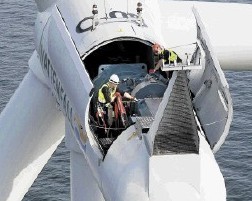
The offshore wind industry needs to learn from the North Sea oil and gas industry and establish an effective framework to ensure the competence of its workforce.
This call by think-tank Wind Energy Update (WEU) comes more than two years after Energy was censured by Renewable UK for questioning the safety competence of the UK’s offshore wind industry.
There are currently 4,700 offshore wind turbines planned to be installed in the North Sea (capacity of 21,400 MW) and 508 turbines in the Baltics (capacity of 2,368 MW).
Germany has already seen the completion of Alpha Ventus and BARD1 windfarms, both of which used some of the most advanced wind power equipment operational today.
However, as planned offshore wind projects become larger in size and farther offshore the developers and contractors who have been scheduled to start construction work face a new problem – a catch-22 situation.
According to WEU, for developers the challenge will be to keep projects moving in line with schedules when there is a lack of clarity on the profiles of the workers needed in order to reach their deadlines.
For contractors, the issue arises from the need to document and then prove a team’s capability in advance of the projects scheduled construction start date.
Jon Harman, head of offshore business at WEU said last month: “The difficulty will be building competence in a way which allows for transfer of teams between projects and meeting the regional legislative demands as well as company expectations on multiple, varied projects and stages of projects.
“If this is not planned for and handled appropriately, there will be a bottleneck in supply of workers every time a project transitions to a new phase or when teams are required for a different project or region.”
Harman says the solution is for a “clear, concise, organised and structured” framework to be established, which can be both monitored and mapped for the workforce.
“This will mean that the competencies required can be rolled out in advance and built to be future proofed,” said Harman.
“In turn this will allow projects to meet timescales, free from struggle, so that the right teams are placed at the right time.
“There are lessons to learn from oil and gas in this respect. A recent example is the IADC (International Association of Drilling Contractors), who have just announced the establishment of a new competence framework for that industry, designed to meet the similar challenges that they are facing.”
According to WEU, the offshore wind community is “united in their views on contract management and workforce competence”.
Recommended for you
